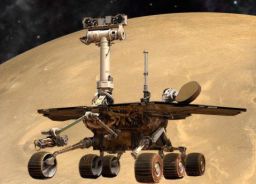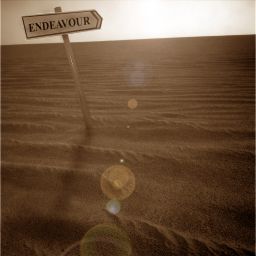A.J.S. Rayl • Jun 30, 2011
Mars Exploration Rovers Update: Opportunity Roves Back into Record Books, Spirit is Honored
Opportunity 'burned up’ the Meridiani Plains in June as it raced toward its much-anticipated next destination and the Mars Exploration Rover (MER) mission cruised into the 90th month of what was originally to have been a 90-day tour.
“We’re driving as fast as we can to Endeavour Crater, that’s the story,” said Steve Squyres, the principal investigator for rover science, of Cornell University during an interview earlier today. And what a story it is.
Now on the last 2-kilometer (1.24-mile) leg of a years-long journey to the huge, 22-kilometer (14-mile) diameter crater crater, the robot field geologist is closing in and taking the team – and people around the world – into a different, older ancient Martian environment on the first overland expedition of Meridiani Planum.
The signature for phyllosilicates, specifically smectite, a family of clay minerals that form in water, has been detected around Endeavour by the Compact Reconnaissance Imaging Spectrometer for Mars (CRISM) instrument, which is onboard the Mars Reconnaissance Orbiter (MRO). If Opportunity can get to these phyllosilicates and sample what appears to be iron-magnesium smectite, then it will have found the best evidence yet found that an alkaline water once pooled or flowed there, in what might have been a past habitat suitable for life.
Phyllosilicates will be a particularly exciting groundtruthing discovery in light of the theoretical model put forth by A. Graraham Cairns-Smith, of the University of Glasgow, in 1985, which hypothesized that clay was the host haven for the emergence of life on Earth. It became known, and has been used as a plausible illustration by other scientists, including famed evolutionary biologist Richard Dawkins, of Oxford University, author of the best-selling book The Selfish Gene (Oxford University Press, 1976).
 Endeavour hills getting closer
Endeavour hills getting closerA range of hills forms the western rim of Endeavour. Pictured here are the hills that lie to the south of Cape York, at Cape Tribulation. Opportunity is headed to Spirit Point at the south end of Cape York, still out of view from the rover's location this month.
Credit: NASA / JPL-Caltech / Cornell / processed, colorized by S. Atkinson
Getting to that smectite will be another huge feather in Opportunity’s mast and it will add one more ‘first’ to the MER mission’s long list of achievements in planetary exploration. More than seven Earth years into the mission, the fact that Opportunity is still going strong and about to enter a whole new phase of discovery is “mind-boggling," offered well-traveled Mars geologist Ray Arvidson, the deputy principal investigator and of Washington University St. Louis, who is also the leader of the Surface Geology subteam for CRISM.
Despite – or maybe because the last of the pre-programmed recovery signals that Mars Odyssey sent to Spirit June 8th went unanswered, bringing an anti-climactic final curtain down on her twin – Opportunity kicked things up a notch again in June, setting more records, including longest backward drive ever by a rover on Mars and covering more than a kilometer in a matter of two weeks.
"We're are thrilled," said Ashley Stroupe, one of the Spirit rover drivers who transitioned recently to Opportunity. "We won't be able to maintain that kind of progress all the time, but it was just such a thrill to watch it count up so fast over such a short time this month. Every day looking for that downlink to see if we broke the record.”
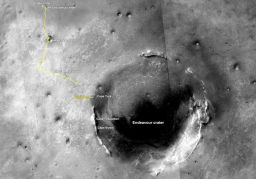 Eagle to Endeavour
Eagle to EndeavourThe yellow line on this map shows where Opportunity has driven from the place where it landed in January 2004, inside Eagle crater (at the upper left end of the track) to a point about 2.2 miles (3.5 kilometers) away from reaching the rim of Endeavour crater. In honor of Opportunity's rover twin, the team has chosen Spirit Point as the informal name for the site on Endeavour's rim targeted for Opportunity's arrival at the big crater. Spirit, which worked halfway around Mars from Opportunity for more than six years, ceased communication in March 2010.The base map is a mosaic of images from the Context Camera on NASA's Mars Reconnaissance Orbiter. It is used by rover team member Larry Crumpler of the New Mexico Museum of Natural History and Science, Albuquerque, for showing the regional context of Opportunity's traverse.
Credit: NASA / JPL-Caltech / MSSS
“This vehicle is operating almost as perfectly as she did on landing,” added Bill Nelson, chief of the rover engineering team at the Jet Propulsion Laboratory (JPL). “There are specific aches and pains we've managed to work around. But this has been an incredibly robust and productive rover.”
To get the picture: Opportunity has to drive mostly backwards now because of a “hot” right front wheel, and her broken shoulder means she has to leave her robotic arm slight deployed, hanging like a fisherman’s pole out the front which is in the case of driving the back, and her miniature thermal emission spectrometer (Mini-TES) doesn’t work. But the rover hasn’t let any of those handicaps stop this expedition.
Endeavour Crater has been Opportunity’s destination ever since it finished exploring Victoria Crater in September 2008. It will be the biggest hole in the ground the rover will tour, and it promises to take the team back to the Noachian Period, between 4.1 and about 3.7 billion years ago, when the oldest extant surfaces of Mars were formed, giving them the access to geological deposits older than the robot field geologist has ever seen. Opportunity is now so close to this wondrous geological attraction that the energy and excitement among team members is brimming over. “We can almost taste it,” said Squyres.
The first place the rover will make landfall is a location at the southern tip of Cape York, a place the team with much affection named Spirit Point. It could be pulling up to the chosen location as early as “late August,” projected Stroupe. “I’m not making any promises,” offered Squyres, not surprisingly.
It is, after all, Mars. Just like on Earth, anything can happen any time. That disclaimed, “we’re just going to keep on driving and driving,” said Squyres. Thus the prime directive for Opportunity remains the same, and with next to nothing to distract it for the next kilometer, the rover will rove on in July and August putting as much real estate behind it as possible until it pulls up to Spirit Point.
“There isn't a lot between now and Spirit Point for about another kilometer, so you can expect at least for the next kilometer we're going to go pretty much pedal to the metal,” Nelson confirmed. "It's drive, drive, drive, and more drives," added Arvidson, noting that the team has plans to stop only one more time to take a sampling of bedrock and soil for an ongoing terrain study.
 Rover family portrait
Rover family portraitFull-scale models of three generations of Mars rovers: Sojourner (center), which landed with Mars Pathfinder on July 4, 1997; the Mars Exploration Rovers Spirit and Opportunity (left), which landed on Mars on January 4 and 25, 2004; and Mars Science Laboratory's Curiosity, set to launch for Mars in November or December 2011.Credit: NASA / JPL-Caltech
Back down at the JPL, where the rovers were “born” and are being managed, the MER team underwent a change of scenery. With the loss of Spirit, and the arrival of the Mars Science Laboratory (MSL) and the Curiosity rover at the Kennedy Space Center this month, the MER crews were moved off of their own floor in building 264 at the Lab where the planetary science missions are ensconced, and to smaller digs, joining MRO and Odyssey on another floor, as MSL moved up to take command of the MER’s former floor and its big conference room.
“Of course, we have the collegiate attitude of the more-the-merrier on Mars,” said Nelson. “MSL is one of our sister projects and we certainly wish them well.”
But as some of their colleagues are reassigned, they may be feeling a little picked on too as they watch their forces shrink along with their space despite all the achievements and accolades and headlines, event though the mission continues to rewrite the science and robot engineering texts.
Then again, every member on an “aging” mission knows the routine well. “We did that too when we were a big mission, and what we did to projects then, the new big missions are doing to us now,” rationalized Nelson, as he considered the stack of crates piled up in one corner of his office. “That's just the nature of the way things work here. But we're continuing to get getting work done and we're continuing to plan,” he added in something of an understatement.
What hasn’t been lost is the MER team’s enthusiasm, heart, and competitive spirit. Interestingly, finding phyllosilicates, those minerals that form in water, was one of the objectives for the MSL and Curiosity, which are slated for launch just after Thanksgiving, in late November 2011, with landing to follow in August 2012. But all bets right now are on MER to deliver that science “gold” – and long before Curiosity can even set wheels in motion on Mars.
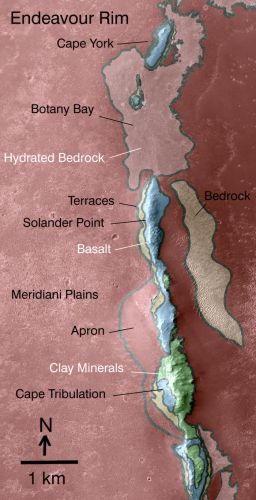 Endeavour west rim map
Endeavour west rim mapThis geological map -- based on observations by the Compact Reconnaissance Imaging Spectrometer for Mars (CRISM) on NASA's Mars Reconnaissance Orbiter -- indicates some of the information gained from orbital observations of Endeavour Crater, the long-term destination for Opportunity since September 2008. Endeavour is about 22 kilometers (14 miles) in diameter. As indicated by the scale bar of one kilometer (0.6 mile), this map covers only a small portion of the crater's western rim. A discontinuous ridge runs north-south, exposing basalt (coded blue) and clay minerals (coded green) believed to be from a time in Martian history before the deposition of sulfates on the portions of the Meridiani Plains region that the rover has seen during its first seven years on Mars. The rover team plans to begin Opportunity's exploration of the Endeavour rim near Cape York, which is about 6.5 kilometers (4 miles) from the rover's location in mid-December 2010. Cape York is nearly surrounded by exposures of hydrated bedrock. From there, the planned exploration route goes south along the rim fragment Solander Point, to Cape Tribulation, where clay minerals have been detected.Credit: NASA / JPL-Caltech / JHU-APL
“We have the potential to go look at something that they were baselining MSL to go discover,” marveled Stroupe. “The fact that we will be getting to Endeavour before they even launch is incredible. I don't know how the MSL scientists feel about, it but we are thrilled to be continually finding things that weren't even imagined when we started out.”
The MER mission may be a one-rover show now, but that one rover is known as a “glamour girl,” as engineer Jake Matejevic, one of the original rover designers has put it, and it certainly seems like she’s doing everything a robot can do to stay on the road, perform well, and stay in the science spotlight. “Now that we're working just Opportunity, it does seem she's doing everything possible to make sure our mission keeps getting attention,” said Stroupe. “And by this rover doing such an amazing job,” she added. “it does ease the loss of Spirit a little bit.”
NASA officially declared Spirit’s mission over on May 25, 2011 after more than 1300 electronic missives were ultimately greeted with only the staticky sounds of radio silence. In the halls and offices of the rover’s team of engineers and scientists however, Spirit’s “spirit” looms large. Among the MER-A’ers, Troy is now being called Spirit Station. "We're informally using that title now and eventually want to try to make it more formal," confirmed Stroupe, who lays claim to being the first woman driver on Mars, with Spirit her charge.
Assessing the emotional aftermath of Spirit's loss this month, it is clear that the engineers are having a little more trouble saying “good-bye” to Spirit than the scientists. It is understandable. "They are the engineers and it is their vehicle and their job is to get the vehicles to their destinations,” Arvidson pointed out. “while our job as scientists is to understand Mars. They naturally become more attached.
“We've definitely become very attached,” Stroupe agreed. Reflecting back on the last month still isn’t easy. “It's been –," she pauses momentarily, then continues the thought, “– tough, trying to let go of Spirit. We do think of her as a team member, and definitely think of the rovers pretty much as living entities, especially because they are autonomous. They go off and do their things, and then call home to let us know how they're doing. Up until the very last moment, we all had hopes Spirit would wake up and call home. Every other time she's managed to pull things out at the last minute, so even though we have been without her now for over a year, that really wasn't time in which we were saying ‘good-bye.’ We just assumed she was coming back. So it's been difficult …” she said.
“But at the same time, there's just so much to celebrate with Spirit," Stroupe continued, echoing the sentiments offered in the May 2011 MER Update by Scott Maxwell, the lead rover driver. "So it's hard to be too sad. Of course, we miss her. But she just accomplished so much and went so far beyond anybody's expectations that we've really been celebrating her more than mourning. That’s a nice feeling. And because this mission has been from the beginning such a great vision – led by Steve Squyres, who is just an incredible inspiration to everyone he meets – and we have each had the privilege of sharing his vision and coming along for the ride. From the beginning, we have always had this sense of grand purpose working with these rovers, and with each other. We all really have a sense of that."
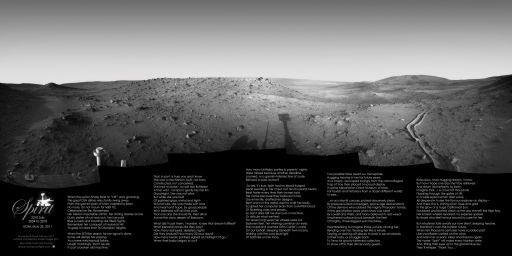 Spirit R.I.P.
Spirit R.I.P.One of the most distinctive, heartfelt, and inspired things to have emerged from the MER mission are the poemsters created by Stuart Atkinson, the poet, and Glen Nagle, the producer-illustrator. Presented here is "Spirit," the end of mission tribute courtesy Atkinson and Nagle, both of UnmannedSpaceflight.com. Appreciation also goes to the MER team, which decided at the beginning to make all the rovers' images available to anyone with a computer and internet connection, in near real time.Credit: S. Atkinson / G. Nagle / NASA / JPL / Cornell / UMSF
With Endeavour clearly in view the engineers are amped and the scientists are almost effervescing. "On a scale of 1 to 10, what is 10? Really excited? Yeah, I'm close to really excited," admitted Arvidson, the team’s resident, stoic Swede.
The MER mission has produced countless banner headlines during the last seven and a half years, and has achieved public recognition the likes of Apollo, Gemini, and Mercury, and Voyager. It has gained priceless worldwide attention and goodwill, demonstrated remarkable advances that show the strength of American engineering, science and technology, transforming two golf-cart sized roving robot field geologists, along the way, into icons known and loved all over the planet – all for a really-big-bang-for-the-buck price-tag of under $1 billion to date. That’s less than the U.S. budget for any given week in Afghanistan. Or, as one statistician determined, the rovers have cost American taxpayers each $0.01.
Still, in these strained economic times, even as there is a cry for American students to take more interest in science and engineering, there's debate in Washington about the importance of planetary exploration. So Squyres is spending this week “deep in congressional staffers’ offices,” said Arvidson, "trying to save the Mars Program in the halls of Congress."
Many people outside of Washington would rephrase the question: how can we not continue exploring? There are academic volumes written on the subject, but in the words of Carl Sagan, Planetary Society co-founder and noted Cornell astronomer:“The open road still softly calls like a nearly forgotten song of childhood. We invest far off places with a certain romance. Your own life or your band’s or even your species might be owed to a restless few, drawn by a craving they can hardly articulate or understand, to undiscovered lands and new worlds.”
For now, Opportunity roves on, continuing to discover and uncover the world of Mars, about to begin, once again,a whole new endeavour for the first time.
Opportunity from Meridiani Planum
After finishing an investigation of a rock target called Valdivia with the instruments on her instrument deployment device (IDD) in late May, Opportunity drove into June, heading on her south/southeast route to Endeavour Crater’s western rim.
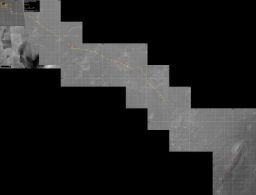 Opportunity route map
Opportunity route mapHere is Eduardo Tesheiner's latest route map for Opportunity. It goes right up to the rover's latest drive on its Sol 2637 (June 25, 2011). Opportunity is schedule to get back on the "Meridiani Highway" on her Sol 2642 (July 3, 2011).
Credit: NASA / JPL / UA / MSSS / E. Tesheiner
On Sol 2614 (June 1, 2011), Opportunity put 146 meters (479 feet) behind her, crossing the 30-kilometer (18.64 mile) odometry mark on the way, bringing her total mileage to 30.06 kilometers (18.68 miles).
The rover began the month with power levels still hovering around 400 watt-hours, working under hazy skies with an atmospheric opacity or Tau of 0.860. But the trademark Martian dust, however slightly and slowing, is beginning to dissipate and the overall view began to improve.
Just two sols later, one the rover’s 2616th Martian day (June 3, 2011), Opportunity went on to set a new one-sol backward driving distance record with a rove exceeding 165.67 meters (541 feet). Her forward driving record of 220 meters (721 feet), which she set way back on Sol 410 (March 20, 2005), still holds so Opportunity is the undisputed Rover Drive Queen of Mars.
Do the rover engineers even celebrate anymore?
"We do note it but we lost the people who used to make the celebratory cookies and fudge brownies aren't here and the people who remain are not cooks, so the records these days are not exactly being celebrated the way the way they used to be," said Nelson. And, judging by Opportunity’s track record, it almost seems as if every new milestone is nothing more than a matter of taking care of business for this rover.
As the first week of June came to an end, Opportunity was again passing through a kind of field dotted with crater impacts, which the scientists suspect are all from the same impact event way back when.
 The DSN's Goldstone antenna
The DSN's Goldstone antennaThe DSN currently consists of three deep-space communications facilities placed approximately 120 degrees apart around the world: at Goldstone, in California's Mojave Desert; near Madrid, Spain; and near Canberra, Australia. This strategic placement permits constant observation of spacecraft as the Earth rotates, and helps to make the DSN the largest and most sensitive scientific telecommunications system in the world. The 70-meter antenna at Goldstone, picture here, was brought back into service in early November 2010, after eight months of maintenance that included replacing the runners.Credit: NASA
The plan to conduct a drive-by shooting of a young crater the team named Gemini 5 on Sol 2620 (June 7, 2011) had to be postponed when a Deep Space Network (DSN) problem prevented the uplink of the rover’s commands. Opportunity was rescheduled to drive on her Sol 2621 (June 8, 2011), and she completed successfully that assignment with a rove of 86 meters (282 feet) that took her around the northern edge of Gemini 5 Crater, stopping midway to take pictures.
During the second week of the month, Opportunity kept on keepin’ on, drive on her Sols 2622 (June 9, 2011, and again on Sols 2627,2628, and 2629 (June 14,15,16, 2011) using a combination of blind driving and autonomous navigation and putting 345 more meters (1132 feet or 0.21 mile) on her rocker bogie.
“On Sol 2626 (June 14, 2011), we passed the 19-mile mark at 30,577.5 meters – and we ended up at 30,658.18 meters,” noted Nelson.
In between and after those drives, Opportunity tended to other tasks, including working with the Mini-TES team to conduct additional diagnostic tests in hopes of getting further insights into the instrument's anomalous behavior, which began several months ago.
And, what the team had been hoping for blew in right in the middle of June on Sol 2627 (June 15, 2011). Mars whipped up a gusty kiss that appears to effectively cleared some of the dust from the rover’s solar panels. "The clearing probably all happened at one time, late on Sol 2627, so the bump in energy didn't really reflect until Sol 2628 (June 16, 2011). But when it reflected, the engineers could only smile and breathe easier. The rover’s power levels jumped by about 100 watt-hours, enabling Opportunity to increase her solar energy production to 528 watt-hours.
As June progressed, http://www.planetary.org/explore/topics/mars_exploration_rovers/ continued making excellent progress driving along the chosen route to Endeavour Crater and the site of “first landfall,” a spot on the southern edge of the ridge dubbed Cape York that the team named Spirit Point in honor of Opportunity's rover twin during “a fitting” tribute, as Arvidson defined it, late last month.
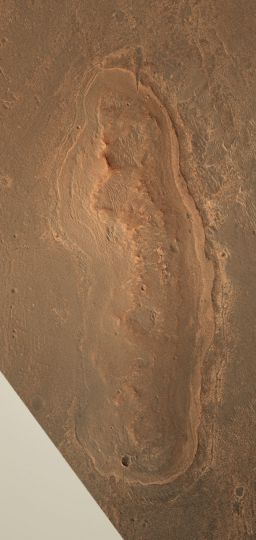 Cape York in natural Martian color
Cape York in natural Martian colorThis image, taken by the Hi-RSIE camera onboard the Mars Reconnaissance Orbiter shows the rim of Endeavour and Cape York in natural Martian color, thanks to Stuart Atkinson's skillful image manipulation. "I joined together four different zoomed-in crops of the feature in order to give me one single, sharp image, but it was worth it," he says. Indeed.Credit: NASA / JPL-Caltech / University of Arizona
Forging ever onward, Opportunity headed southeast during four more sols of driving, logging 146.49 meters on Sol 2629 (June 17, 2011) and 144.64 meters on Sol 2630 (June 18, 2011) During the three-sol weekend plan, the rover also turned on and positioned her alpha particle X-ray spectrometer (APXS) for overnight measurement of atmospheric argon on Sol 2631 (June 19, 2011).
On Sol 2633 (June 21, 2011), Opportunity drove for 80.32, and then stopped. "We capped drive, because we were seeing a large number of seconds on the rover's inertial measurement unit (IMU) or gyro," said Nelson. "Gyro drift is a problem, as it is with all gyros, so we stopped the drive to do a reset (aka ‘quick fine attitude’ or QFA) – to correct for that drift.
With Opportunity’s improved energy though, the team decided to implement an early morning wakeup for an AM ultra-high frequency (UHF) relay pass on Sol 2634 (June 22, 2011), so the rover could offload more data and free up more memory. The rover then took a quick jaunt of 16.7 meters.
“Our day begins with the handover [the rover’s receipt of commands from Earth] and ends with the overflight [of Mars Odyssey which collects data from the rover to send home to Earth], and on that particular sol, there was a late handover and an early afternoon Odyssey pass,” explained Nelson. “Our allocations just fell out that we couldn't get our uplink until fairly late and that happened to be a sol where the overflight came early. It pressed our day and limited what we could do.”
Opportunity made up for it the next sol, logging a good 138.8 meters on her 2635th Martian day (June 23, 2011). But the rover is in restricted sols, which means, in effect, the rover can only drive every other day at most. But after a sol of remote sensing on 2636 (June 24, 2011), Opportunity clocked 126.46 meters on Sol 2637 (June 25, 2011), then spent a couple more sols resting and taking more pictures of her surroundings.
The rover was to have driven again Tuesday, her Sol 2640 (June 28, 2011), but another DSN issue meant the commands couldn’t get there in time, so the rover waited and spent that sol and the sol following taking pictures and making other remote sensing observations.
At just 2 kilometers away Endeavour is beckoning louder than ever and with her newfound energy, Opportunity seems raring to go. "I remember when the decision was made to go to the Columbia Hills with Spirit, and there was a lot of doubt among the team members,” recalled Stroupe. “We just weren't sure. The rovers were still very new and we weren't sure how they were going to perform. But by the time we were got to Victoria and started talking about going to Endeavour I don't think there was a shadow of a doubt in anybody's mind that we would get there. And that's the mode we've been in."
 Endeavour in 3-D
Endeavour in 3-DGet your blue/red glasses and check out this 3-D picture of Endeavour Crater, Opportunity's next big attraction. Stuart Atkinson took this image from Google Mars, stretched it vertically to see more detail in the topography, and then rendered it in 3-D. "I love this view," he say. "It really shows very clearly the uneven nature of Endeavour's floor, and how those eastern, crater-spattered hills dominate the whole crater."
Credit: Google Mars / S. Atkinson
"Failure wasn't in folks' minds," Arvidson remembered. "It only became a question of ‘how quickly can we get there,’ and ‘what can we do along the way,’ and ‘let's not promise date, because we don't know what we'll see or what problems we'll have’. We did think we’d be able to get to Endeavour," he confirmed.
"The Martian winds have scared us quite a few times, but on the whole they've been better to us than they have been bad,” Stroupe pointed out. “They come along and clean us off every season, enough to keep us going. We’ll be getting to Endeavour at the right time in the mission. We're prepared and we've got lots of experience and have lots of tools in our toolkit now on how to handle these difficult terrains. We're going to – I don't know what – but we will find amazing things there. It's so exciting."
As always, the highs are balanced by the lows. Despite Opportunity’s blistering roves during the first three weeks of the month and her newfound power, this week presented a "downturn in the curve" for driving. "Not only are we restricted sol mode where we can only drive every other day, but we have [the July 4th] holiday, meaning we could only drive twice," explained Stroupe. "And a problem with the DSN lost that uplink for the drive."
Space stuff happens. Opportunity will spend the July 4th weekend doing a little work and a little driving. If all things go as planned, the rover will get back on the road to Endeavour on her Sol 2645 (July 3, 2011).
The rover will cruise on through July and into and through August. Whatever sol Opportunity winds up at Spirit Point will be a sol marked in the minds of every MER crewmember and mission follower. "We have about 2000 meters to go now, so it won't be long," assured Arvidson.
Now, as June turns to July, there’s nothing but the Endeavour Hills for as far as the rover’s “eyes” can see. The next set of craters that have caught the collective eye of the scientists is a good kilometer away. Opportunity may stop for a weekend next month to sample the bedrock and topsoil for the ongoing study of the terrain. "For the most part, right now, there's isn’t a lot to slow us down," said Nelson. "There’s nothing for a kilometer that the scientists want to see, not yet anyway, and certainly there's nothing in the engineering that would indicate we are about to suffer a problem or that we need to do anything special.”
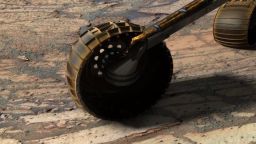 Rove on, Opportunity
Rove on, OpportunityThis rendered image of Opportunity was produced using "Virtual Presence in Space" technology, developed at JPL. It combines a photorealistic model of the rover and a false-color mosaic taken by the rover on Sol 134 (June 9, 2004) with its panoramic camera while in Endurance Crater.
Credits: Rover model by Dan Maas, synthetic image by Zareh Gorjian, Koji Kuramura, Mike Stetson and Eric M. De Jong.NASA / JPL / Cornell
The outlook, even for the coming Martian winter, is bright. Even before this month’s dust-clearing event, the "power people" at JPL did a study on what winter would be like for Opportunity. “It looked difficult, but eminently do-able,” noted Nelson. Then the Martian wind blew. “So I'm feeling optimistic about this winter. Mars could always throw us a curve, but it looks like we should be in good shape this winter.”
Nelson expects the next winter projection sometime in the next 30 days or so, and when he gets it he expects that the latest clearing will enable Opportunity to continue driving through the winter. “As opposed to finding a winter haven and tilt and sit there, which this rover has never had to do."
The rovers planners (RPs), meanwhile, are getting ready for Opportunity’s arrival at Endeavour and are discussing and reviewing drive strategies, taking into account all of their terrain experience on Mars. "It's still all very preliminary and it will depend on when we get there and see what the ground is really like," said Stroupe. "We've been driving on almost completely flat ground since we left Victoria. Some of the slopes along the Endeavour rim are more gradual, and some are steeper, and we’re getting back into that mode of operating in this kind of rocky terrain.
“It turns out that Cape York and Husband Hill share similar thermal inertia properties and similar spectral properties with the exception of the phyllosilicates,” added Arvidson. “They look like basaltic sands that are coarse enough, so we're not going to have a lot of sinkage, I don't think. We're working with the rover planners for the best plan of attack to get to those outcrops [that are harboring the phyllosilicates], which are tilted inboard toward Endeavour, 5 to 15 degrees. What we'll probably do is approach Cape York from Botany Bay, the southern side of Cape York, and then turn to the north and drive along the topographic contour, rather than trying to go up and over. Despite the fact that it has similar thermal and spectral properties to Husband Hill, we haven't been in that particular terrain, so you want to kind of toe-dip and kind of work your way in and not try to go straight down.
It will be a challenge, in any case, because it always is. “Just because we've done this a few times before, this area is likely different because every place is different, with a different surface,” Stroupe explained. “It might be more bedrock and it might be sandier.”
Even so, Opportunity now has all the MER drivers weighing in and willing to put his/her efforts into the planning. “We now have the best prepared team with the most experience, from all of our previous craters, and all our mountain-driving. We can bring all that to bear to make sure we're using the best strategies. We're going to have to take our time and figure out the terrain as we go, but we're all very excited about it. For us drivers, we want the challenges. We want to climb up the steep hill, and go to the interesting places, and look at the big rocks. So we're really looking forward to being able to get there and see what it's like, finding where the good stuff is, and really putting our minds together to figuring out the best paths and the best ways to approach the chosen targets.”
The MER team continues making good use of the “intelligence” coming down in the images from the HiRISE camera, and Michael Malin’s Context Camera (CTX), as well as CRISM, also onboard the Mars Reconnaissance Orbiter. “As we've gotten closer, and especially over the last couple of months, we’ve been updating [plans] on what we've been finding so far,” said Arvidson.
Scientists and engineers, together, are also beginning to work more with the Adams Rover Terramechanics and Mobility Interaction Simulator (ARTEMIS) a multi-element, dynamic, 3-D model, in preparation for the Endeavour adventure.
Squyres, not surprisingly, won’t venture an arrival date for Opportunity at Spirit Point. But the drivers are calculating the meters and counting the sols, and they’re ready. "We're anticipating now – unless we find something interesting to stop at look at for a while – arriving there and taking our first peek inside that crater probably around late August,” predicted Stroupe. “We're all looking forward to it. It never gets old. Seeing the pictures coming in and talking about what we're going to do.”
The MER science team has already blocked out Opportunity’s initial science campaign. Once the rover has paid her respects at Spirit Point, she will begin an investigation at Botany Bay, the exposed bedrock just south of Cape York and before Solander Point, the other big promontory in the immediate area. “One can see from HiRISE and also CRISM that once we're close to Cape York a lot of the windblown soil cover disappears and Botany Bay exposes a lot of bedrock where we can see evidence for hydration in the rocks, so that's the first aerially extensive bedrock that has a distinctive spectral signature for the presence for water in the minerals as seen from CRISM, and we’re going to check that out."
 Mineral map of Endeavour's western rim
Mineral map of Endeavour's western rimCRISM spectral maps of Endeavour's western rim show smectite (red) associated with the upraised rim rocks and hydrated sulfate minerals (blue) associated with the lower-elevation sedimentary fill. The image is roughly 1.5 kilometers wide. Credit: NASA / JPL / UA / JHUAPL
Mobility there should be, Arvidson suggested, “a snap.” What's of interest to the scientists is that part of Botany Bay tilts inward toward Endeavour, up to about 10 degrees. “So, if the sedimentary rock that we've been looking at, these dirty evaporite sandstone formed in ancient playa or a lakebed environment, and then kind of redistributed by wind, and then was cemented by rising groundwater, then on a 5 to 10 degree slope on Botany Bay we should see some differences relative to the flat areas we've been driving on,” he explained. “Because you're not going to have a lake tilted at 10 degrees, right?”
It should be, Arvidson ventured, “a set of springs or channels,” which he expects will be evidenced in the rocks that we'll be looking at. “We'll be looking for water changes in the textures and appearance of the bedrock, because it does look like the bedrock does conformably drape over Endeavour's eroded down topography," he continued.
From there, Opportunity will travel to Cape York proper, the older Noachian terrain. “There are benches there we want to look at, these strata that encircle Cape York, and there are a few of them,” said Arvidson. “They may be some of the youngest dirty evaporite deposits that we'll encounter, and they may be preserved from erosion, because they're snug up against the Noachian crust exposed on Cape York. So we'll take a look at those."
Opportunity will likely take her time in taking in Endeavour. To get the iron-bearing mineral phases with Mössbauer these days, the rover will have to spend a week on any given target. Not to mention that this is the biggest deepest crater the rover will study.
The team won’t rush, but they will not waste a minute either, for the big phyllosilicates prize, the pot of science “gold” at the end of the Endeavour rainbow, is on the inboard side of Cape York facing Endeavour.
"What we'll do once we get there is work out the specific science objectives for each of those areas: the rock in Botany Bay, the benches and the phyllosilicates in Cape York, and then we'll basically respond to discoveries. But, the driving reason for the extended mission, besides exploration and discovery, is to confirm the presence of these iron-magnesium smectite clays,” said Arvidson. So the prime target, in the case of any doubt, is the inboard side of Cape York, likely to present the most dangerous terrian for the rover.
 A fantasy scene of the Endeavour Hills
A fantasy scene of the Endeavour HillsThis is another in Stuart Atkinson's series of "Would probably look nothing like that in real life, but it's pretty anyway…" views of sunset over the Hills of Endeavour. For more of Atkinson's work check out his blog: RoadtoEndeavour.wordpress.com
Credit: NAA / JPL-Caltech / Cornell / produced by S. Atkinson
There is much more smectite further down the coast, on Cape Tribulation. “That’s where the motherlode is, but that's 80 meters high and tilts 20-25 degrees inboard to Endeavour, a difficult target to get to," said Arvidson.
Neverthless, there is little doubt that once Opportunityis finished at Cape York, the team won’t be able to resist a sail to the south. That’s the thing about rovers. They rove. And for the MER mission, Opportunity is once again about to start all over again as she carries the torch of exploration and discovery on Mars.
Support our core enterprises
Your support powers our mission to explore worlds, find life, and defend Earth. You make all the difference when you make a gift. Give today!
Donate

 Explore Worlds
Explore Worlds Find Life
Find Life Defend Earth
Defend Earth


